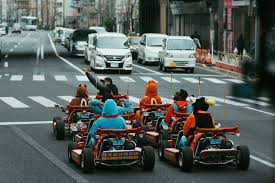
Mario Kart Tokyo has revolutionized how we experience kart racing games, particularly through its exciting real-world integration and immersive gameplay. Whether you’re a long-time fan of the Mario Kart franchise or new to the scene, the Tokyo version offers something entirely unique. From vivid cityscapes to personalized characters and vehicles, it’s more than just a game—it’s an experience. In this article, we’ll explore 10 game-changing things that will completely shift the way you approach Mario Kart Tokyo.
1. Real-Life Tokyo Streets as Your Racetrack
One of the most exciting features of Mario Kart Tokyo is that the game is designed around the actual streets of Tokyo. You’re not just racing on virtual tracks anymore—you’re zipping through iconic neighborhoods like Shibuya, Shinjuku, and Akihabara. This adds a fresh sense of realism and adventure, especially if you’ve visited or plan to visit Tokyo.
Experience the Sights and Sounds of the City
From neon-lit signs to bustling intersections, the atmosphere immerses you in Tokyo’s vibrant energy. This realism influences how players approach turns, shortcuts, and racing strategies, making the experience far more dynamic than traditional tracks.
2. Real-Time Multiplayer Enhancements
In Mario Kart Tokyo, multiplayer mode has reached new heights. Unlike older versions where players raced only against AI or online avatars, this edition allows you to play in real-time with others who are physically nearby or globally connected.
Strategy Becomes Crucial
Because you’re dealing with real opponents who can think and adapt, your approach needs to be tactical. Mastering the art of defense, item usage, and shortcut exploitation becomes far more essential.
3. Augmented Reality Integration
One of the most groundbreaking elements is the use of augmented reality (AR). Whether you’re racing on your phone, a console, or a specially equipped kart in real-life, AR adds another layer of interactivity.
A New Dimension of Racing
Virtual obstacles, power-ups, and enemies can appear in real locations, meaning you have to stay alert and think fast. This transforms every race into a unique challenge and changes how you plan your movements.
4. Customizable Karts and Characters
Unlike previous games, Mario Kart Tokyo offers highly detailed customization for both karts and characters. You can personalize almost every element—wheels, colors, gliders, and even outfit styles.
Your Setup Affects Performance
These aren’t just cosmetic changes. Different parts impact your speed, acceleration, and handling. Choosing the right combination for the Tokyo terrain can be the difference between winning and losing.
5. Cultural Influence on Game Elements
The game incorporates many elements of Japanese culture, from the music to the design of karts and the power-ups. There are also Tokyo-exclusive items and events tied to real-life festivals and holidays.
Think Beyond Traditional Items
Understanding these new cultural elements can give you an edge. Items like “Sakura Boosters” or “Ramen Rockets” offer strategic advantages unique to the Tokyo environment.
6. Weather-Based Track Changes
Weather isn’t just a visual change in Mario Kart Tokyo—it actively affects gameplay. Rain, fog, and even snow can alter the physics of the game, requiring different approaches to cornering and drifting.
Adaptability is Key
Players must learn to adapt their racing style based on current conditions. For example, wet roads require more careful drifting, while fog might obscure visibility, demanding heightened reflexes.
7. Integration with Local Landmarks
Landmarks like Tokyo Tower, the Imperial Palace, and Rainbow Bridge aren’t just background visuals—they’re part of the track itself. You’ll race around, through, and sometimes inside these structures.
Strategic Use of Landmarks
Learning the layout and features of each landmark can give you an edge. Use narrow alleys for shortcuts, and watch for jumps near bridges to gain speed boosts.
8. Unique Power-Up System
In Mario Kart Tokyo, the power-up system has evolved. There are new items exclusive to this version, including localized effects and dual-item usage. Timing and placement become even more critical.
Prioritize Over Power
It’s not just about what power-up you get, but when and where you use it. For example, using a speed boost in a congested intersection might backfire, while saving a banana peel for a tight corner can block incoming shells.
9. Frequent Live Events and Competitions
Nintendo has embraced the esports culture with Mario Kart Tokyo, offering weekly and monthly live tournaments. Many events are themed around local Tokyo culture or international holidays, keeping things fresh.
Prepare Like an Athlete
Success in these events requires preparation. Studying maps, practicing precision turns, and upgrading your kart parts all contribute to staying competitive.
10. Real-World Kart Experience Option
In addition to the virtual game, Tokyo offers real-world karting experiences where players can dress up as their favorite characters and race through the city streets in custom go-karts (within legal boundaries). This takes immersion to a whole new level.
Practice Makes Perfect—Virtually and Physically
Many gamers use the virtual game to prepare for the real experience, and vice versa. Mastering Tokyo’s streets in the game can significantly enhance your confidence and performance in real-life karting tours.
Conclusion: Mario Kart Tokyo Redefines the Racing Genre
Mario Kart Tokyo is not just another installment in the franchise—it’s a complete reimagining of how racing games can be experienced. With its real-world integration, cultural flair, and innovative features, it demands more from the player than ever before. These 10 changes will not only elevate your gameplay but transform your overall appreciation for what a racing game can be. Whether you’re playing at home or zooming through the actual streets of Tokyo, the game challenges you to adapt, strategize, and immerse yourself like never before.